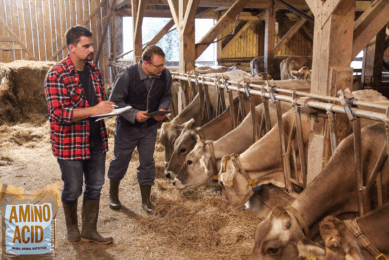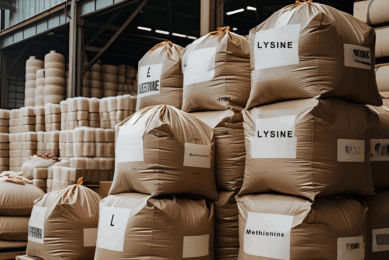The amino acid response to phytase
Adding phytase to monogastric diets increases the digestibility of phosphorus and calcium. But there is less data available on the effect of adding phytase on amino acid digestibility. More understanding on this interaction is therefore needed.
Whilst the benefit of adding phytase to pig and poultry diets is largely undisputed, the nutrient uplift values manufacturers attribute to their products can vary markedly. This is particularly the case for amino acid release values. To improve understanding in this complicated area, 2 meta-analyses were recently carried out by DSM, analysing peer-reviewed amino acid digestibility trials with phytase in pigs and poultry. The aim of the research project was to provide accurate information on amino acid response to phytase and to reduce some of the confusion caused by the varying recommendations for different products on the market.
3 main conclusions were apparent from these published evaluations:
- Firstly, while at lower doses of phytase supplementation there was a direct relationship between phosphorus release and improvement in amino acid digestibility, at higher doses this relationship did not exist.
- Secondly, the response to phytase was significantly different between individual amino acids.
- Finally, the amino acid response patterns seen in broilers were different from those seen in pigs.
The need for further evaluation
Adding phytase to monogastric diets increases the digestibility of phosphorus, calcium, sodium, amino acids and trace minerals. This is a result of the enzyme’s ability to break down phytic acid, which is present in cereals, their by-products and vegetable protein ingredients. In doing so, it reduces the negative effects of this anti-nutritional factor. Whilst the consequences of this action are relatively clear-cut for phosphorus and calcium, there is less data available on the response in amino acid digestibility. This is likely because trials that evaluate amino acid digestibility are expensive to carry out and give highly variable results. This, in turn, means that manufacturers of phytase must devise amino acid matrix values for their products based on relatively small variable data sets. Different approaches when extrapolating such data for practical use leads to widely varying matrix values for amino acids. By conducting a meta-analysis of all peer-reviewed data from the last 20 years, the aim was to gain a more comprehensive understanding of amino acid responses to phytase. In the analysis, 28 and 24 papers, for pigs and broilers respectively, were considered. These included studies with all the most commonly used phytase products, at a range of doses and in a variety of diets.
Figure 1 – The relationship between phytase inclusion level and apparent ileal amino acid digestibility in broilers.

Relationship to phosphorus release
Phytase is routinely added to pig and poultry diets at 500 or 1000 FYT (units of phytase). It is also becoming increasingly common to use much higher doses of 1500 FYT, 2000 FYT or more, to increase the nutritional value of diets and enhance animal performance. Evaluation of data from the broiler meta-analysis found that when the phytase dose was doubled from 500 to 1000 FYT, the phosphorus release and amino acid digestibility increased in direct relation to each other. This clear relationship meant that the response for amino acid digestibility rose from ~2% to over 4%. From this, it could be expected that increasing the dose further would elicit a greater increase in both. However, this was not the case. The authors found that there was little additional benefit in amino acid availability with inclusion levels of phytase above ~1000FYT (Figure 1), despite the phosphorus response continuing to increase. The same was true in pigs, where increasing the dose from 250 to 2000 FYT also had little effect on amino acid digestibility, but increased phosphorus release. This divergent pattern is logical given the preference phytases have for the highly phosphorylated and more anti-nutritional IP6 and IP5 isomers of phytate. Breakdown of lower, less anti-nutritional IP esters continue to release phosphorus, but additional amino acid digestibility benefits are limited.

Species differences in phytase response
Not only was the average magnitude of amino acid release by phytase lower for pigs than broilers (mean increase of 2.8 vs. 4.1% respectively for mean digestible phosphorus release of ~0.07%), the response in individual amino acids was different (Figure 2). The first observation implies phytate may be less of an anti-nutrient in pigs compared to poultry. The level of dietary phytate in the broiler meta-analysis was negatively correlated to the amino acid digestibility. This relationship is well known to be the result of an increase in endogenous protein secretion into the intestine to maintain gut integrity with increasing phytate content. Therefore, not surprisingly, the efficiency of phytase to destroy dietary phytate in the broiler has a significant bearing on amino acid digestibility. In this evaluation, digestibility of amino acids in broilers was improved by between 1.5% and 3%, when less than 10% of dietary phytate was destroyed. This increased to 10% when half of the phytate was degraded. In pigs, the relationship between the increase in ileal amino acid digestibility and the breakdown of phytate was less clear. This suggests the beneficial effects of phytase on amino acid digestibility in swine may come more from improvement in dietary protein digestibility and less from changes in endogenous amino acid flow.
Figure 2 – Relationship between the digestibility of amino acids in broiler diets and swine diets.

Amino acid individuality
The effect of phytase on ileal amino acid digestibility in both pigs and broilers was generally greater for those amino acids with lower inherent amino acid digestibility. For example, cysteine is poorly digested, whilst methionine is much more highly digestible in most ingredients and diets. It therefore makes sense that phytase can improve the digestibility of cysteine more. This was clearly demonstrated in the broiler evaluation, where the coefficient of apparent cysteine digestibility was 6.2% but only 0.3% for methionine (Figure 3). These unique trends in the response to phytase by individual amino acids however, are not always reflected in practical matrix values. Not taking these patterns into account can be detrimental to the formulation of a nutritionally balanced diet. Despite these general trends, there are also some important differences in specific amino acid response patterns when comparing broilers to pigs. A key observation was that there was significantly less improvement in the digestibility of sulphur amino acids in pigs than in poultry (<1% vs ~3.5% respectively). this difference has substantial implications for formulation of diets with phytase and appropriate sulphur-amino acid concentrations. clearly, it is not correct to use the same amino acid matrix values for phytase, in pigs and poultry.>
Figure 3 – Mean improvement with phytase on individual amino acid digestibility in broilers.

Advice to nutritionists
The results of these meta-analyses offers clear evidence that phytase increases ileal amino acid digestibility in both broilers and pigs. The data also adds to the understanding of the mechanisms behind this action. They also show the importance of scrutinising amino acid matrix values before applying them in practical feed formulation. Key points to remember are:
- Amino acid responses are lower in pigs than in poultry: 1-4% vs 2-6%.
- The pattern of response between individual amino acids should follow distinct patterns and
- These patterns are species-specific and dependent on inherent differences in digestibility of each amino acid and
- Amino acid responses to phytase are proportionate to phosphorus release ONLY up to an inclusion level of ~1000FYT, after which they plateau
Matrix values that do not follow these rules should be treated with some caution.
References are available on request.
Author:
Adam Smith, DSM Nutritional Products











